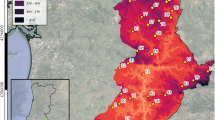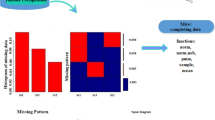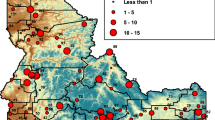Abstract
Multiple missing levels are explored to quantify a threshold of missing values during gap filling processes in daily precipitation series. An autoregressive model was used to generate rainfall estimates and subsets of data are selected with four sampling windows (whole data, front, middle, and rear section) at different missing levels, including 5, 10, 15, 16, 17, and 18 %. The proposed threshold was found and evaluated based on statistical criteria, including coefficient of determination (R2) and its associated index termed “the R2 difference index (RDI).” The result indicates that about 15 % missing level of data is plausible to construct daily precipitation series for further hydrological analysis when the Gamma distribution function (GDF) is used as an estimation method. The threshold determined from this study will contribute to gap filling guidelines, especially for water managers and hydrologists to take advantage of skillful estimates for missing daily precipitation data.






Similar content being viewed by others
References
Ahrens B (2006) Distance in spatial interpolation of daily rain gauge data. Hydrol Earth Syst Sci 10:197–208
Akaike H (1973) Information theory and an extension of the maximum likelihood principle. In: Petrov BN, Csaki F (eds), 2nd International Symposium on Information Theory, 267–281
Aksoy H (2000) Use of gamma distribution in hydrological analysis. Turk J Eng Environ Sci 24:419–428
Calder IR (1993) In handbook of hydrology. Maidment D (ed.), McGraw-Hill, New York, 18.12–18.13
Chattopadhyay S, Jhajharia D, Chattopadhyay G (2011) Univariate modelling of monthly maximum temperature time series over northeast India: neural network versus Yule-Walker equation based approach. Meteorol Appl 18(1):70–82
Dirks KN, Hay JE, Harris D (1998) High-resolution studies of rainfall on Norfolk island part II: interpolation of rainfall data. J Hydrol 208(3–4):187–193
Garcia M, Peters-Lidard CD, Goodrich DC (2008) Spatial interpolation of precipitation in a dense gauge network for monsoon storm events in the southwestern United States. Water Resour Res 44(W05S13):1–14
Goldberg AS (2000) A course in econometrics. Harvard University Press, Cambridge
Goswami M, O’Connor KM (2007) Real-time flow forecasting in the absence of quantitative precipitation forecasts: a multi-model approach. J Hydrol 334(1–2):125–140
Hasan MM, Croke BFW (2013) Filling gaps in daily rainfall data: a statistical approach. 20th International Congress on Modeling and Simulation, Adelaide
Hipel KW, McLeod AI (1994) Time series modelling of water resources and environmental systems. Elsevier, Amsterdam
Hubbard KG, Goddard S, Sorensen WD, Wells N, Osugu TT (2005) Performance of quality assurance procedures for an applied climate information system. J Atmos Ocean Technol 22(1):105–112
Ing C-K, Sin C-Y, Yu S-H (2010) Efficient selection of the order of an AR (infinity): a unified approach without knowing the order of integratedness. Econometric Society, 10th World Congress, Shanghai
Linsley RK, Kohler MA, Paulhus JLH (1982) Hydrology for engineers. McGraw-Hill, New York
Ljung GM, Box GEP (1978) On a measure of lack of fit in time series models. Biometrika 65:297–303
Mair A, Fares A (2011) Comparison of rainfall interpolation methods in a mountainous region of a tropical island. J Hydrol Eng 16(4):371–383
Markovic RD (1965) Probability functions of best fit to distributors of annual precipitation and runoff. Hydrology papers Colorado State University, Fort Collins, P 119
Ryu JH, Palmer RN, Wiley MW, Jeong S (2009) Mid-range streamflow forecasts based on climate modeling-statistical correction and evaulation. J Am Water Resour Assoc 45(2):355–368
Salas JD, Delleur JW, Yevjevich V, Lane WL (1980) Applied modeling of hydrologic time series. Water Resources Publications, LLC, P.O. Box 2841, Littleton, CO 80161, USA, pp468
Sevruk B (1996) Adjustment of tipping-bucket precipitation gauge measurements. Atmos Res 42(1–4):237–246
Simolo C, Brunetti M, Maugeri M, Nanni T (2010) Improving estimation of missing values in daily precipitation series by a probability density function-preserving approach. Int J Climatol 30(10):1564–1576
Sprinthall RC (2011) Basic statistical analysis. 9th edn. Pearson Education Group
Teegavarapu RSV (2014a) Statistical corrections of spatially interpolated missing precipitation data estimates. Hydrol Process 28:3789–3808
Teegavarapu RSV (2014b) Missing precipitation data estimating using optimal proximity metric-based imputation, nearest-neighbor classification and cluster-based interpolation methods. Hydrol Sci J 59(11):2009–2026
Teegavarapu RSV, Tufail MI, Ormsbee L (2009) Optimal functional forms for estimation of missing precipitation records. J Hydrol 374:106–115
Teegavarapu RSV, Meskele T, Pathak C (2011) Geo-spatial grid-based transformation of precipitation estimate using spatial interpolation methods. Comput Geosci. doi:10.1016/j.cageo.2011.07.004
Westerberg I, Walther A, Guerrero JL, Coello Z, Halldin S, Xu CY, Chen D, Lundin LC (2010) Precipitation data in a mountainous catchment in Honduras: quality assessment and spatiotemporal characteristics. Theor Appl Climatol 110:381–396
Wilks DS (1995) Statistical methods in the atmospheric sciences. Academic Press
Author information
Authors and Affiliations
Corresponding author
Appendix
Appendix
The Gamma Distribution Function (GDF):
Where, F(x) is CDF of gamma distribution, f(x) is the probability density function of the gamma distribution, x is precipitation at the time step, \( \overline{x} \) is the mean precipitation of specific month, s is the standard deviation of the specific month, α is the shape parameter, β is the scale parameter, Γ is the gamma function.
Coefficient of determination (R2): R2 is given by
where, PQi is the observed precipitation data at time step i, PSi is the estimated precipitation data. \( {\overline{P}}_{Qi}\; and\;{\overline{P}}_{Si} \) are the mean of the observed and estimated precipitation data, respectively. N is sample size.
Rights and permissions
About this article
Cite this article
Kim, J., Ryu, J.H. Quantifying a Threshold of Missing Values for Gap Filling Processes in Daily Precipitation Series. Water Resour Manage 29, 4173–4184 (2015). https://doi.org/10.1007/s11269-015-1052-5
Received:
Accepted:
Published:
Issue Date:
DOI: https://doi.org/10.1007/s11269-015-1052-5




